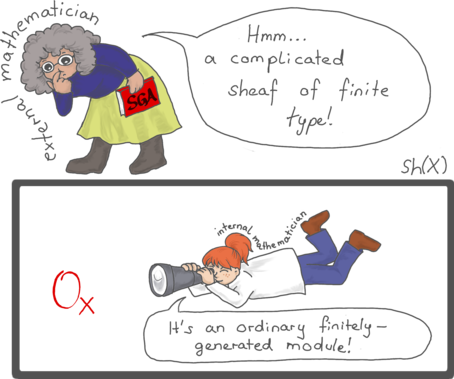Any scheme has its associated little and big Zariski toposes. These toposes support an internal mathematical language which closely resembles the usual formal language of mathematics, but is "local on the base scheme": For example, from the internal perspective, the structure sheaf looks like an ordinary local ring (instead of a sheaf of rings with local stalks) and vector bundles look like ordinary free modules (instead of sheaves of modules satisfying a local triviality condition). The translation of internal statements and proofs is facilitated by an easy mechanical procedure.
We investigate how the internal language of the little Zariski topos can be exploited to give simpler definitions and more conceptual proofs of the basic notions and observations in algebraic geometry. To this end, we build a dictionary relating internal and external notions and demonstrate its utility by giving a simple proof of Grothendieck's generic freeness lemma in full generality. We also employ this framework to state a general transfer principle which relates modules with their induced quasicoherent sheaves, to study the phenomenon that some properties spread from points to open neighborhoods, and to compare general notions of spectra.
We employ the big Zariski topos to set up the foundations of a synthetic account of scheme theory. This account is similar to the synthetic account of differential geometry, but has a distinct algebraic flavor. Central to the theory is the notion of synthetic quasicoherence, which has no analog in synthetic differential geometry. We also discuss how various common subtoposes of the big Zariski topos can be described from the internal point of view and derive explicit descriptions of the geometric theories which are classified by the fppf and by the surjective topology.
No prior knowledge about topos theory or formal logic is assumed.
- Expository notes (PDF)
- Slides (PDF) for GAeL 2013
- Poster (PDF) for GAeL 2014
- Slides (PDF) and video for Topos à l'IHÉS 2015
- Slides (PDF) for PSSL 99
- Slides (PDF) for the Category Theory Seminar at the Centre for Mathematical Sciences in Cambridge
- Slides (PDF) for the Algebraic Geometry Seminar in Warwick
- Slides (PDF) for the Oberseminar Algebra/Geometrie/Topologie in Düsseldorf
- Slides (PDF) for PSSL 101
- Slides (PDF) for PSSL 103
- Slides (PDF) for the Oberseminar Mathematische Logik in München
- Slides (PDF) for FilMat 2018
- Slides (PDF) for UNILOG 2018
- Slides (PDF) for Toposes in Como 2018
- Slides (PDF) for the Group Seminar of Jürgen Jost's group in Leipzig
- Slides (PDF) for the Colloquium Logicum 2018 in Bayreuth
- Slides (PDF) for PSSL 104 in Amsterdam
- Slides (PDF) for the Münchenwiler Meeting Autumn 2018 in Münchenwiler
- Slides (PDF) for the Logic Seminar in Padova*
- Slides (PDF) for the 6th Workshop on Formal Topology
- Slides (PDF) for Category Theory 2019
- Slides (PDF) for Proof and Computation 2019
